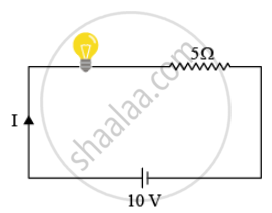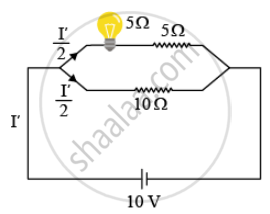Advertisements
Advertisements
प्रश्न
A current of 1 ampere flows in a series circuit containing an electric lamp and a conductor of 5 Ω when connected to a 10 V battery. Calculate the resistance of the electric lamp.
Now if a resistance of 10 Ω is connected in parallel with this series combination, what change (if any) in current flowing through 5 Ω conductor and potential difference across the lamp will take place? Give reason.
उत्तर
Let the resistance of the electric lamp be Rlamp.
Current (I) = 1 A
Resistance of conductor (Rconductor) = 5Ω
Potential difference of battery (V) = 10 V

Since the lamp and the conductor is connected in series, thus same current 1 A will pass through both of them.
Using Ohm's law,
`"R"_"net" = "V"/"I"`
`"R"_"net" = 10/1`
`"R"_"net" = 10`Ω
`"R"_"net" = "R"_"lamp" + "R"_"conductor"`
⇒ 10 = Rlamp + 5
⇒ Rlamp = 5Ω
Potential difference across lamp,
Vlamp = I × Rlamp = 1 × 5 = 5V
When 10Ω resistor is connected parallel to the series combination of lamp and conductor (Rnet = 5 + 5 = 10Ω) then the equivalent resistance,

`1/("R"_"eq") = 1/10 + 1/10 = 2/10 =1/5`
⇒ Req = 5Ω
Using Ohm's law
`"I"^"'" = "V"/"R"_"eq"`
⇒ `"I"^"'" = 10/5`
⇒ `"I"^"'" = 2 "A"`
Current will distribute equally in two parallel parts.
Thus, `"I"^"'"/2 = 1"A"` current will pass through both the lamp and the resistor of 5Ω (because they are connected in series).
Potential difference across the lamp (Rlamp) = 5Ω
`"V"_"lamp"^"'" = 1 xx 5 = 5"V"`
Hence, there will be no change in current through the conductor of resistance 5Ω, and potential difference across the lamp.
APPEARS IN
संबंधित प्रश्न
What is the unit of electric charge?
Name a device that help to measure the potential difference across a conductor.
What do you understand by the term "potential difference"?
The device used for measuring potential difference is known as:
The values of potential difference V applies across a resistor and the corresponding values of current I flowing in the resistor are given below:
| Potential differences, V (in volts) | : | 2.5 | 5.0 | 10.0 | 15.0 | 20.0 | 25.0 |
| Current, I (in amperes) | : | 0.1 | 0.2 | 0.4 | 0.6 | 0.8 | 1.0 |
A p.d. of 10 V is needed to make a current of 0.02 A flow through a wire. Wire p.d. is needed to make a current of 250 mA flow through the same wire?
Three electric cells of potential difference 1.5 V each have been connected as a battery. The potential differences of the battery will be ____________ V.
Two bulbs are marked 100 W, 220 V and 60 W, 110 V. Calculate the ratio of their resistances.
Define electric potential and potential difference.
Electric potential is a measure of the ______ on the unit positive charge to bring it to that point against all electrical forces.
